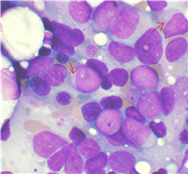New drug helps narrow racial survival disparity in patients with acute myeloid leukemia: Study

Non-Hispanic Black patients with acute myeloid leukemia (AML) are living longer, now that new therapies are available, according to a study presented by researchers from the University of Pennsylvania Perelman School of Medicine and Penn Medicine’s Abramson Cancer Center at the 65th American Society of Hematology (ASH) Annual Meeting and Exposition.
In the past, the standard treatment for AML, a cancer that affects the blood and bone marrow, was intensive chemotherapy. Unfortunately, many older patients were ineligible to receive this treatment because the side effects were too harsh, which translated to poor survival. In November 2018, venetoclax, a new targeted therapy drug that’s given in pill form in combination with other medicines, was approved for AML. This marked the beginning of a new “modern era” for AML treatment, where patients who would have been considered too old or too sick for chemotherapy now had access to a viable treatment option.
In this retrospective study, the researchers found that since venetoclax was approved, AML survival has improved, particularly among non-Hispanic Black patients. The predicted two-year overall survival rate (adjusted for age and comorbidities) for non-Hispanic Black patients with AML rose from 28.6% to 45.3%, mitigating the survival gap compared to non-Hispanic white patients.
The study used a nationwide electronic health record-derived database to compare survival trends of nearly 3,000 adult patients diagnosed with AML between January 2014 and December 2018 to another set of approximately 2,000 patients diagnosed in the modern era of treatment, between January 2019 and October 2022, after ventoclax and other research advances made their way into the clinic.
“Historically, AML has been a very difficult cancer to treat, so we’re encouraged to see outcomes improving, including the narrowing of health disparity gaps for the first time,” said first author Xin Wang, MD, a third-year fellow in Hematology-Oncology at Penn.
“Racial and ethnic disparities in cancer care are complex, but our study shows that when novel therapies are brought into the ‘real-world’ setting, including community hospitals, we can move the needle. On the clinical research side, we need to take advantage of these opportunities to better serve previously under-represented, under-studied populations.”
The researchers set out to learn more about existing racial/ethnic disparities in AML and to assess whether the approval of new low-intensity treatments, including venetoclax–and subsequent shift toward more outpatient and community-based care delivery–had an impact on those disparities. They found that overall survival improved in this modern era of AML treatment, particularly among those age 70 and older.
Patients who received treatment were older in the modern era cohort, with a median age of 71 compared to 68.5 in the cohort diagnosed before venetoclax approval. Non-Hispanic white patients saw a more modest improvement in overall survival, while survival did not improve for Hispanics in modern AML care.
“These results are the first step to better understanding racial and ethnic disparities in modern AML care and should be explored further in broad, multi-institutional prospective collaborations,” said co-senior author Kelly Getz, Ph.D., MPH, an assistant professor of Epidemiology and Pediatrics.
The team’s continued research is focused on assessing how other factors may have impacted overall survival trends. While this study has shed light on the evolving racial/ethnic disparities in AML survival, more studies are needed to better understand why such outsized improvement was seen in non-Hispanic Black patients. The researchers note that this demographic was underrepresented in venetoclax clinical trials, and it’s unclear whether biological features (such as cancer mutations), non-biological factors (such as subsequent therapy and/or access to care), or a combination is responsible for the difference.
“We hope to extend this work with basic science, translational, and qualitative research experts to obtain a more comprehensive view,” said co-senior author Catherine Lai, MD, MPH, an associate professor of Hematology-Oncology and physician leader of Penn Medicine’s Leukemia Clinical Research Unit. “Ultimately, our goal is to further improve the outcomes of all patients with this very challenging disease.”
Source: Read Full Article
